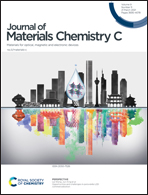Deep red SrLaGa3O7:Mn4+ for near ultraviolet excitation of white light LEDs
Abstract
Red luminescent phosphor SrLaGa3O7:Mn4+ was prepared by the traditional high-temperature solid-state reaction. The structural characteristics, luminescence properties and the performance of this phosphor were investigated in light-emitting diode devices. Deep red emission peaking at ∼715 nm was observed under the excitation wavelength in the range of 220–550 nm, which is related to the charge transfer band of Mn4+–O2− and the 4A2g → 4T1g, 4A2g → 2T2g and 4A2g → 4T2g transitions of Mn4+. In particular, SrLaGa3(1−x) O7:3xMn4+ exhibits the strongest absorption in the near ultraviolet region (350–410 nm). This feature can well match the emission of current commercial near-ultraviolet chips, and is expected to be used in white LEDs. Moreover, we also conducted a thermal quenching experiment on the SrLaGa3O7:Mn4+ phosphor, and the obtained activation energy was 0.4 eV, indicating that the quenching temperature is (T50%) 370 K. Finally, the application of the SrLaGa3O7:Mn4+ phosphor in constructing a LED device was explored. At a driving current of 20 mA, the Commission on Illumination (CIE) coordinates of the device are (0.3281, 0.3080), with a high color rendering index (CRI) of 91.9 and a low corresponding color temperature (CCT) of 4315 K. Experimental results show that the phosphor has broad prospects in preparing white LED devices excited by near-ultraviolet light.



 Please wait while we load your content...
Please wait while we load your content...